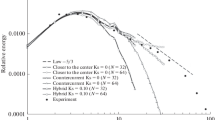Abstract
A turbulent flow around a NACA4412 airfoil is simulated by a segregated finite element method based on the SIMPLE algorithm and the low Reynolds numberk-ω turbulence model. The originalk-ω model and a modified version of thek-ω, model (shear stress transport model) are adopted, for which grid independent solutions are obtained, respectively. From the present numerical experiment, it has been shown that the segregated finite element method with thek-ω turbulence model can predict the turbulent flow leading to separation satisfactorily with apparently reduced memories compared with the mixed integrated formulation. It is also recommended that for the analysis of external flows a modifiedk-ω model should be used instead of the originalk-ω model, which combines the features of both the standardk-ε model and the originalk-ω model.
Similar content being viewed by others
References
Choi, H. G. and Yoo, J. Y., 1994, “Streamline Upwind Scheme for the Segregated Formulation of the Navier-Stokes Equation,”Numerical Heat Transfer, Part B Vol. 25, pp. 145–161.
Coles, D. and Wadcock, A. J., 1979, “Flying-Hot-Wire Study of Flow past an NACA4412 Airfoil at Maximum Lift,”AIAA J. Vol. 17, No.4, pp. 321–329.
Hastings, R. C. and Williams, B. R., 1987, “Studies of the Flow Field near a NACA4412 Airfoil at Nearly Maximum Lift,”Aeronautical Journal, pp. 29–44.
Jansen, K., 1995, “Preliminary-Large Eddy Simulations of Flow around a NACA4412 Airfoil Using Unstructured Grids,”CTR Annual Research Briefs, NASA Ames Research Center, pp. 61–72.
Menter, F. R., 1994, “Two-Equation Eddy Viscosity Turbulence Models for Engineering Applications,”AIAA J., Vol. 32, No. 8., pp. 1598–1605.
Rice, J. G. and Schnipke, R. J., 1986, “An Equal-Order Velocity-Pressure Formulation That Does Not Exhibit Spurious Pressure Modes,”Comput Methods Appl. Mech. Engrg., Vol. 58, pp. 135–149.
Wadcock, A. J., 1987, “Investigation of Low-Speed Turbulent Separated Flow around Airfoils,”NACA CR 177450.
Wilcox, D. C., 1988, “Reassessment of the Scale-Determining Equation for Advanced Turbulence Models,”AIAA J., Vol. 26 No. 11, pp. 1299–1310.
Author information
Authors and Affiliations
Rights and permissions
About this article
Cite this article
Chung, ST., Choi, H.G. & Yoo, J.Y. An analysis of turbulent flow around a NACA4412 airfoil by using a segregated finite element method. KSME International Journal 12, 1194–1199 (1998). https://doi.org/10.1007/BF02942593
Received:
Issue Date:
DOI: https://doi.org/10.1007/BF02942593




